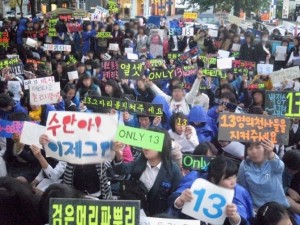 K-pop companies have group construction down to a science, so much so that we can break down groups and identify each member’s individual contribution: the dancer, the visual, the main vocalist, the variety star, and everything else in between. But what happens when a group’s foundation is disrupted by the inclusion of a new member?
K-pop companies have group construction down to a science, so much so that we can break down groups and identify each member’s individual contribution: the dancer, the visual, the main vocalist, the variety star, and everything else in between. But what happens when a group’s foundation is disrupted by the inclusion of a new member?
Let’s flash back to 2010 when Wonder Girls added then-JYPE trainee Hyelim to the group after Sunmi went on hiatus to focus on her academics. The fan response from Wonderfuls was loud and resistant, with most opposing JYPE’s official statement that a six-member Wonder Girls was better than a four-member Wonder Girls.
Over time, the general public came to accept Hyelim as a member of the group, but the phenomenon of companies adding new members, especially when an established member leaves, remains a trend in the industry despite the controversy surrounding it.
The second-most important feature of an idol group, besides whether it is composed of boys or girls, is how many members it has. One comes to realize that the specific number of members in a given K-pop group is very important for K-pop companies to determine and maintain. When rumors spread about trainees on the cusp of debut, it’s often the number of members that we hear about first.
Rumors of a 12-member boy group from SM Entertainment was out for years before the company debuted the final product EXO to the public, and the size of Girl’s Generation influenced other companies to aspire to “Divine Nine” girl groups of their own.
Even after a group’s first few years in the spotlight when members come and go, they have a major stock in attempting to reestablish equilibrium by adding members to fill the gaps. Every time a member of After School leaves, trainees step up to compensate. In reality, most groups have some form of graduation system if members can’t leave a group without being replaced by others, and the evidence is everywhere.
Returning boy group U-Kiss added trainee Jun after AJ left to continue his studies at Columbia University. KARA, who had a member implosion last year, has an ongoing reality show to fill the vacancies left by Nicole and Jiyoung’s departures.
T-ara has had a confusing five-year run with departures and additions at every turn. There are some major exceptions: 2PM and TVXQ continued on without replacements, likely because the controversy of adding on new members vastly outweighed the controversy of continuing on with missing links.
 This is an issue where fans and companies often don’t see eye to eye. While entertainment executives usually want to get as close to the original number of members as possible, fans are die-hard proponents of group integrity, wanting only original members in the group and no intruders.
This is an issue where fans and companies often don’t see eye to eye. While entertainment executives usually want to get as close to the original number of members as possible, fans are die-hard proponents of group integrity, wanting only original members in the group and no intruders.
The response to Jun has been rather mild thus far, but fans have already rallied against the Kara Project for ruining the original conception of the group. And even the controversy surrounding KARA is nothing compared to the vitriolic Only13 movement among some Super Junior fans over the pseudo-inclusion of Henry and Zhou Mi in Super Junior proper.
It’s somewhat of a Catch 22 for K-pop companies, which work so hard to develop that culture around a group and facilitate it internally, as the members of an idol group typically develop a camaraderie based upon their shared experiences as trainees and as members of the group they represent. Adding a new member to an established group down the line can cause tensions. Whether or not bullying occurred in T-ara, it is clear that 2010 add-on Hwayoung didn’t connect with her group members very well.
Hyelim also admitted to initial discomfort joining an established group on KBS Star Life Theater.
Truthfully I wasn’t comfortable before. During fan events, I used to think people didn’t want my autographs but just got them simply because I was there, and they had to.
It’s difficult to have good timing when a company has to add a new member to a popular group, as there will always be backlash from purists. Alternatively, no one talks much of Yubin replacing Hyuna in the Wonder Girls back in 2007 because the group was still in their first year and not juggernauts in the industry just yet. Any major moves and shakes in the group lineup after that window is a huge risk for a company to take, yet most will still go for it if it suits their interests.
Despite hardships, there are still some group additions that have gone well. Without After School adding members, Nana and Lizzy may have never gained the same level of popularity they enjoy now. Kyuhyun is undeniably a critical vocal asset to Super Junior that many may have forgotten he was added to the group in 2006.
Still, it’s difficult to anticipate which addition will be a perfect fit to a group, and which addition feels like an intrusion.
New members are put under the critical microscope to a harsher degree. Not only are they evaluated on the basis of their individual skills but also by how well they “fit” with the group they just joined. The new member can’t just be a great singer/dancer/visual/variety star; they also have to have the “look” in order to fit in with their senior members. And unless this new member hit the jackpot in their timing, fans normally won’t be receptive even if he or she can satisfy everything on the checklist.
 To companies, the numbers game may be based on absolutes, but there are so many intangibles to whether a member addition or replacement will work out in a given group. This is one area where companies are often willing to ignore the desires of their consumers, anticipating that most fans will still buy in to the group even if there’s one or two new additions that they don’t like.
To companies, the numbers game may be based on absolutes, but there are so many intangibles to whether a member addition or replacement will work out in a given group. This is one area where companies are often willing to ignore the desires of their consumers, anticipating that most fans will still buy in to the group even if there’s one or two new additions that they don’t like.
I’d say that 99.9% of the time, the entertainment company has the right idea. With an established group comes established fans, who won’t turn their back on their beloved original members.
In reality, the numbers game mixes a little bit of fan psychology with K-pop economics, and the only people who win regardless are the companies. For everyone else, be it fans, original members, and new additions, it’s all one huge crapshoot.
Are group additions necessary in certain situations, and which specific additions in K-pop history have gone particularly well or poorly? Is maintaining a group’s size important to you?
(KBS, The Korea Times, YouTube)


